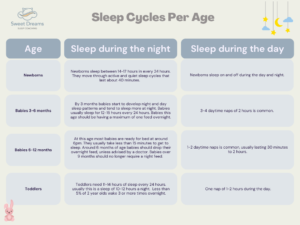Parents are often puzzled by their child’s sleep patterns. With so much science involved it’s our intention to simplify the detail for you. Understanding how sleep cycles work can be a game-changer in your approach to sleep, whilst also supporting your sleep training journey. In this blog, we explain the stages of sleep, their impact, how they develop as babies grow, and our advice for using this knowledge to support better sleep.
What Are Sleep Cycles?
Sleep cycles are the patterns of sleep, comprising of different stages that occur multiple times during the night. Typical adult sleep cycles usually last around 90-120 minutes. As adults sleep less hours per night than children (ideally!), they have fewer sleep cycles per night. Sleep cycles for children are shorter, typically 30-60 minutes long, depending on the age of the child. They also sleep more than adults, so they have more sleep cycles per night. It’s important to know this as the more sleep cycles per night the more potential there is for overnight wakings, due to the need to ‘link’ sleep cycles together to minimise wakings. If your child is waking regularly (and it’s not unusual for parents to report to us that their child is waking every hour), it can be attributed to a struggle to link together sleep cycles. This is often due to stage 1 sleep that occurs in every sleep cycle when the potential to be awake happens, as explained below. Although there is a possibility to go into stage 2 sleep, if your child is dependent on a ‘prop’ to fall asleep – such as your help, for example, rocking – then they are likely to wake up each time they are in stage 1 sleep and need that ‘prop’ to get them back to sleep.

The stages can be divided into two main categories:
1. Non-REM (Rapid Eye Movement) Sleep (NREM):
- Stage 1: a state very similar to being conscious, as a person drifts in and out of sleep and they can be easily awakened; also described as partial arousal.
- Stage 2: light sleep, where the heart rate slows and body temperature decreases. This stage accounts for about 50% of total sleep across the whole time a person is in bed.
- Stage 3: Deep sleep, crucial for physical restoration and growth. This stage is harder to wake from and is when the body performs most of its healing. This sleep is signified by the brain waves that occur at this time and is also known as slow-wave sleep.
2. REM Sleep:
- Research shows this is the stage where most dreaming takes place. It is vital for our key cognitive functions such as memory and learning. Brain activity increases compared to NREM sleep and is recognised as rapid eye movement.
How Sleep Cycles Impact Your Child’s Sleep
As they grow, a child’s sleep cycles change. Newborn sleep evolves into the ‘adult sleep’ stage, as defined above, around 16 weeks of age, often known as the 4-month sleep regression. For newborns they oscillate between REM and NREM only and regularly spend up to 50% of their sleep in REM. This reduces after 16 weeks, and the proportion of time spent in REM sleep lessens. So once your child has reached 4 months, they will have more extended NREM periods. This understanding helps you recognise why your child has the potential to wake up more often, since they spend more time in more ‘stages’ and the ‘linking’ of stages and cycles can cause disturbances in their sleep pattern.
- Frequent Waking: If your child wakes up frequently during the night, it may be because they’re transitioning between sleep cycles. This is especially common in younger children.
- Bedtime Resistance: Knowing that children often go through a light sleep stage soon after falling asleep, can highlight why they might resist bedtime. They may be aware of their surroundings and feel anxious about separation. Other factors could include feeding needs or issues such as sleep regression; depending on their age.

Tips for Navigating Sleep Cycles
- Observe and Track: Recording your child’s timings can assist with tracking your child’s total sleep and their wakings. You can use this information to note their unique sleep pattern, when their cycles occur and how to manage any bedtime challenges or overnight disturbances, as well as navigate short naps.
- Optimal Bedtime: A regular bedtime that is consistent every day can ‘trigger’ the right feelings of tiredness for your child and provide a smoother transition into sleep. It helps the goal of children learning to fall asleep independently and resettle between sleep cycles.
- Create a Consistent Routine: If we were to give one tip to every family that is struggling with this it would be: create an age-appropriate bedtime routine as it’s so beneficial to help your child realise that it is time to relax and that sleep is coming next. Being consistent with the routine and timing helps regulate their internal clock (known as the circadian rhythm) and supports a smooth transition into the first, and the linking of, sleep cycles during the night. Having a shorter but regular routine at nap time will help lengthen naps.

- Sleep Cues: Some cues are vital for a helpful transition to sleep; however, many are simply boredom, due to the short attention span of children and the need to change the activity. We are big believers in a timely bedtime as more appropriate than only focusing on cues for the indicator it is sleep time. Again, this applies to naps and being conscious of age-appropriate awake times.
- Manage Night Wakings: It is tempting to be on hand to help your child back to sleep if they wake up during the night. However, if your child is falling asleep on time for their age and awake windows, they have a much better chance of going back to sleep without you. Waiting a few minutes before intervening is our advice. They may be in stage one sleep, partial arousal, and will be able to go back to sleep alone, given the opportunity.
Overview
Sleep is a mystery to many; it just happens to us, and we don’t think too much about it – until we are not sleeping enough, then it rapidly becomes a problem. Before we have children, our sleep is in our own control. If we don’t sleep well, it’s often because of a lifestyle choice and something we can rectify, catching up on missed sleep with an early night or two. When we embark on our parenting journey, we often research a lot of what it will be like to care for a child, and many of us don’t delve into the sleep topic too much. The information shared above should help you understand how your child’s sleep cycles can influence their actual sleep, and hopefully significantly impact your parenting experience, positively. Recognising the stages of sleep and applying this knowledge to your responses and reactions when your child is trying to sleep or wakes, can help your child develop healthier sleep habits. Remember to be patient and flexible as you navigate any challenges you face; a little time, consistency, and perseverance can bring real results.
If you are struggling with sleep issues or have questions about sleep training, we offer personalised and caring guidance to deal with these. Our expert team of sleep consultants offer of a free, 30-minute consultation to help you to achieve your goals.
Sweet Dreams are simply a message or call away!



